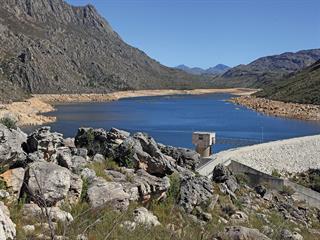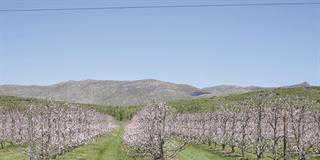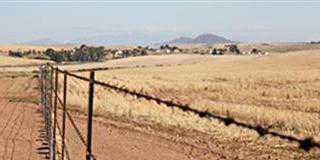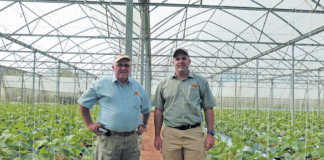
As in many other areas of South Africa, the Ceres Valley has experienced an extremely dry year. The rainy season started late in the past winter and most farms in the region received only about half the annual rainfall of between 800mm and 1 000mm. The region’s dams, usually full by the end of winter, were only 40% to 60% full by the end of the rainy season.
The region’s most important dam, Koekedouw Dam, stood at 35% of its 17,2 million cubic metre capacity at the end of November. The soil is currently moist from the winter rain, and fruit trees are still looking good. There is, however, little prospect of significant rain until autumn next year, so there is a danger of farmers running out of water before winter, according to Louis Reynolds, owner of production consultancy service, Fruitful Crop Advice.

Louis Reynolds
“For optimal production of pome fruit, farmers in the region between Ceres and the Koue Bokkeveld and Witzenberg Valley need 8 000m3 to 9 000m3 of water per hectare from mid-September to the start of May. With dam levels so low, farmers only have access to between 40% and 60%. In effect, water has to be managed carefully to reduce the impact of a possible supply shortage,” he says.
Drought management
Step 1: Calculate the volume of available water
By working out how much irrigation water you have, you can establish the intervention required, Louis explains. Look at the volume of water in your dams as well as alternative sources such as boreholes and run-off water from drainage systems that could be pumped back into dams.
Step 2: Test water quality
If your water is partly saline, either mix it with a large amount of fresh water before irrigating, or apply only a small quantity of the saline water at a time. Short periods of irrigation with saline water should be followed by irrigation with good-quality water to wash out the salts. These practices will prevent salts from building up in the root zone of trees
Step 3: Set priorities
“Identify your most productive orchards, those that are relatively productive, and those that could do with less water without dramatically affecting the farm’s bottom line,” Louis explains. In addition, consider removing orchards that are no longer economically viable and reduce irrigation to young and less productive orchards to free up water for more profitable orchards.
But, cautions Louis, do not restrict irrigation in young orchards to the extent that they fail to bear fruit, as trees carrying fruit are more resilient to drought conditions than trees without fruit. Irrigate heavy soils with silt or clay later in the season and at longer irrigation intervals than sandy soils or soils with a high stone fraction. This is because heavy soils have a higher water retention capacity. In addition, the soil has relatively high moisture levels at the beginning of the season due to the winter rain.
Step 4: Lessen the effect of reduced irrigation
Identify the trees’ physiological development stages to determine when reducing irrigation would have minimal impact. According to Louis, there are two optimal periods: during cell division, which commences with bud break and extends 40 days thereafter, and post-harvest, when trees have to gather reserves for the next season. It is crucial to maintain normal irrigation during the 40 days after flowering – the fruit-ripening phase. “Supplying trees with too little water during this time will have a very negative impact on production,” Louis stresses.
Step 5: Reduce wastage
Inspect your irrigation system regularly to identify and fix problems such as leaks, and broken or blocked sprayers. Remove low-hanging branches or weeds causing obstruction. Run your pumps at the right pressure for optimal functioning.
Water loss as a result of evaporation should be reduced as soon as possible. It’s best to irrigate orchards in the evenings and do so less often but for longer periods.

Farmers have started to remove some orchards a year or two earlier than planned to make water available for more lucrative orchards.
Cover the soil with mulches such as hay, grass or wood chips, especially around young trees. Up to 50% of irrigation water is lost in young orchards due to surface evaporation and the small root systems of young trees.
Profile holes should be dug inside the tree rows to establish where roots are concentrated, as only these areas need to be watered. “It’s not possible to suddenly switch from micro-sprinklers to the more efficient drip irrigation system, as the way in which trees are irrigated has a big impact on root development. You could, however, change to sprinklers with smaller wetting zones to irrigate the root zones. In young orchards, irrigation lines could also be moved closer to the trees to achieve this goal,” Louis says.
Competition from other plant material such as weeds and cover crops, should also be reduced. However, these plants must not be removed mechanically as this could damage the fine roots that grow near the soil surface.
Step 6: Use the right tools for the job
Informed irrigation decisions cannot be made without precise measurements. It is crucial therefore to use the best technology available for this purpose. The most obvious of these are weather forecasting websites. There are a number of these, Louis points out, and they should be consulted regularly to gain as accurate a picture of the weather as possible.
Secondly, ensure that soil moisture meters (continuous logging probes) are working correctly and reflect the precise requirements of orchards in terms of soil type and climatic conditions. Maintain records of each irrigation session: keep track of
the volume of water used as well as the duration of each irrigation application.
Do not use too much nitrogen; this could result in vigorous growth that could increase a tree’s water requirements. Physically examine the soil. “Dig profile holes regularly to see whether there is enough moisture in the soil and keep records of these observations,” stresses Louis.
In short, managing water use during a drought cannot be reactive. It requires a proactive, disciplined approach to minimise potential damage.
How farmers are managing the drought
Pieter Graaff of the farm Dennekruin in the Witzenberg Valley has only 70% of the water needed to last him to the next rainy season. Farm manager, Kallie du Plessis, says dams that are usually full at this time of year are at only 50% of capacity.
Fortunately, the farm has boreholes that can serve as a back-up if dams run dry. As part of the farm’s drought management strategy, Pieter is reducing irrigation by half once fruit has been picked, and using mulches in tree rows to reduce surface evaporation.

Kallie du Plessis, farm manager on Dennekruin, prefers to use rough wooden chips as mulch, because they do not blow away as easily as sawdust.
Handri Conradie, who farms on Koelfontein near Prince Alfred Hamlet, says that on areas of the farm where the water availability is the lowest, he has removed marginal orchards that were due for replacement in two to three years. He also plans to supply the orchards with optimal irrigation for as long as possible in the pre-harvest period, and then cut back post-harvest irrigation to match the available remaining water.
“We’ve greatly improved our water- use efficiency since the last drought in 2004/ 2005. The positive thing about conditions such as these is that it refocuses your attention on every little detail of water management practices and the efficiency of irrigation equipment,” he says.
On Koelfontein, Handri plants only enough orchards for about 70% of the farm’s water capacity. The remainder of the water is carried over as a buffer to be available for use in a dry year.
The difficulty this year is that last summer was drier and longer than usual and winter rain started only in June. This means that Handri, like many farmers, has had to use his water reserves deep into autumn.
With winter rainfall being so low, there was very little run-off and the dams on Koelfontein were at only 45% of capacity for the new irrigation season. Irrigation also had to start earlier than normal in spring due to the low soil moisture content as a result of the dry winter.
Phone Louis Reynolds of Fruitful Crop Advice on 084 709 1726 or email [email protected].













